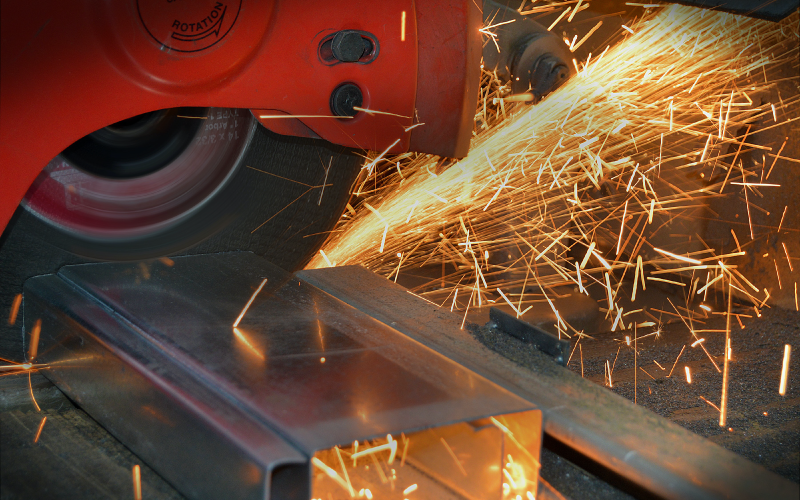Photo by Russ Ward on Unsplash
The digitalization of the European metal and machinery industry is an opportunity for the sector to adopt new perspectives about how to produce and reduce the consumption of energy. New technologies and techniques such as additive manufacturing, Internet of Things, or Cloud computing have an important role to play in the future of the industry as much as the reskilling of the employees.
The world produces enough steel to build up a new Eiffel Tower every three minutes. Metal can be recycled endlessly without any quality loss. However, The World Counts, an organisation that attempts to give an overview on critical global challenges, assures that steel has an enormous adverse impact on the environment. It requires approximately 20 gigajoules of energy to produce one ton of steel: “three-quarters of the energy used to process steel comes from burning coal”.
Knowing the vast energy consumption of the industry, how can it be transformed into sustainable manufacturing?
The 2008 crisis deeply affected the European steel industry
Trade tensions and global growth slowing down have already played the role of disrupters before the outbreak of the Covid-19. Moreover, steel consumption has been falling since early 2019 and European Union (EU) imports have tumbled by 11%. The second-largest producer after China, with 177 million tonnes a year produced, must face more difficulties to match the Chinese production of steel and its competitive prices. Since its major price crisis in December 2015 ($39,6), the iron ore has been increasing and is now not so far to reach its highest price registered ($187,18, February 2011 vs $168,13, Dec 2019).
Before the crisis (December 2007), Iron ore per tonne cost $36,63. The roller coaster of its price is related to the 2008 crisis which has affected deeply the EU steel industry. The butterfly effect can be seen quite well in this case: in 2014 the decline of domestic demand for steel in China (3,3%) followed by a 0,5% declined the next year has totally unbalanced the market. Nevertheless, China does not yet entirely rule the world, if the industrialization of the emerging countries has helped the world market to grow since 2000, the world’s continuous reduction in production costs for major iron ore producers is another important factor for the prices to fall.
The European Commission plans and strategy to digitalize the industry: consolidation and restructuration
The EU steel industry supports nearly 2.5 million Jobs (including indirect and induced Jobs) and creates around €128 billion of Gross Value Added. Approximately, there are 560,000 enterprises that operate in the industry and 6.9 million persons are employed within the machinery sector group. Most of the machinery companies are SMEs, of which the majority are family-owned or employing less than 50 people.
There are 500 production sites in 22 countries of the EU. The industry is aging and is not green enough to meet the EU’s standards on sustainable production and environmental protection. The accessibility to raw materials and the pricing of energy consumption are determining factors that must be considered to achieve sustainable production of steel. In addition, the aging workforce of the steel industry must be considered because it can adversely impact digitalization, a transition that is necessary to help with the reduction of energy consumption.
The digitalization of the steel industry is a pathway to achieve more sustainable energy consumption. However, optimization and process control are the factors that attract more attention and therefore, investment. According to the 2018 McKinsey report on the digital opportunity in metals, data will gain more and more value and the structural position in the cost curve will not be decisive as it is still nowadays.
Since 2014, the Commission has financed an extensive number of projects in the European steel sector to develop technologies such as IoT system, big data analytics, and Cloud computing, production line simulation, self-organizing production, cyber-physical systems, smart supply network, vertical/horizontal integration, predictive maintenance, cyber-security, augmented work, self-driving logistic vehicle, and digitalization of knowledge management.
How Could the Steel Industry Cut CO2 Emissions? A Green Deal on Steel
The reference document “The Best Available Techniques”, presents the conclusions of discussions between the industry, the EU members states, NGOs promoting environmental protection, and the EU. In relation to the main topics that have been treated such as Energy management and Water and waste management, optimization of consumption with the continuous monitoring system and energy efficiency can be increased using a computer-based system.
Since October 2020, the European Steel Association is leading a plan of actions “A green deal on Steel” that would take the sector to adopt important measures: “This initiative can and should serve as the basis for agreement on an action concept at an EU level, with a coordinated approach for the EU’s industry, climate, energy, trade, recovery, and related policies” (EUROFER, 2020). The transition to a carbon-lean is not without cost and in that case, it is numbering in a multi-billion-euro range. Therefore, the association insists on creating the right conditions to ensure an economically healthy transition.
The future of the industry: highly trained workforce
One of the most important industries in the European Union has still a lot to achieve to totally embrace the digitalization era and ensure the necessary transformation that will strongly reduce the consumption of energy. Undoubtedly, funding for new digital technologies is the solution.
Nevertheless, Human capital must also be included in the “investment”: “A modern and competitive steel industry can be built and maintained by a highly trained workforce and a robust industrial base is essential for Europe’s economic growth” (ESSA, 2019).
A similar challenge to other European manufacturing industries is to connect the experienced workers – more reticent to learn and to follow training – with younger workers to preserve the industrial knowledge and combine it with new technologies.
Article by Marjorie Grassler – Communications Executive at Mobile World Capital Barcelona

